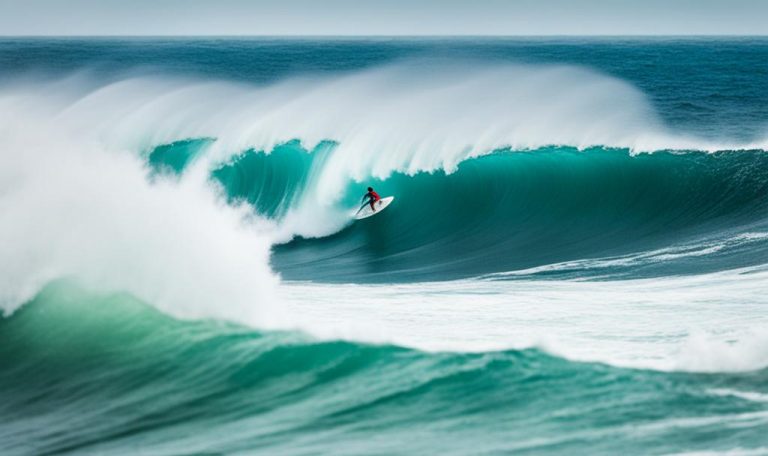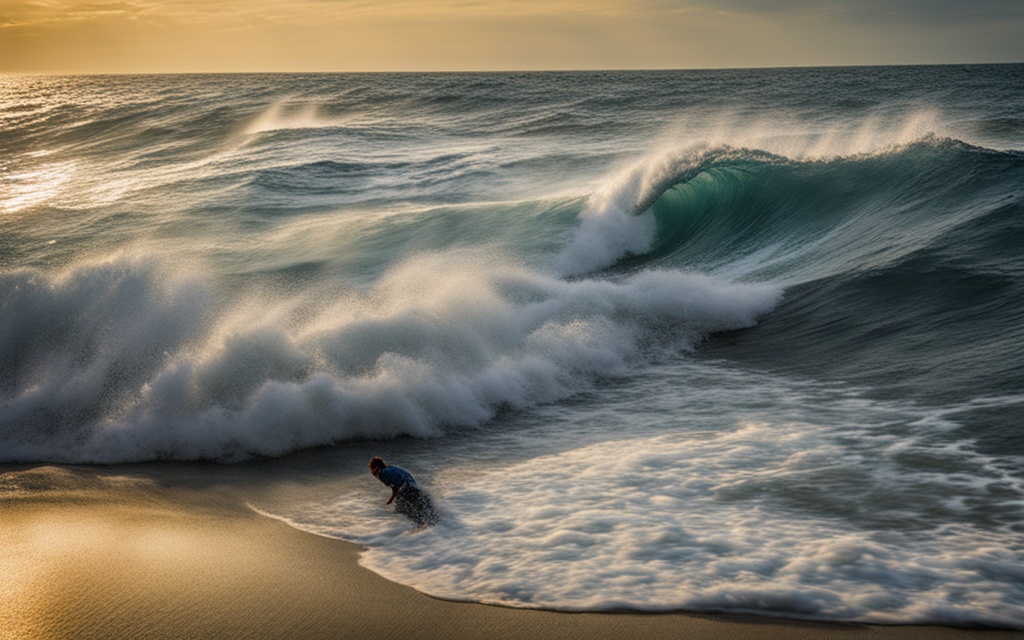Welcome to Panama’s beautiful coastal waters, where you can relax, soak up the sun, and enjoy the vibrant marine environment. However, it’s essential to prioritize safety when venturing into these waters, as they can pose potential risks. One significant danger to be aware of is rip currents.
Rip currents are powerful, narrow currents that flow away from the shore, sometimes called undertows. They have the ability to swiftly pull swimmers out to sea, putting their safety at risk. It’s crucial for all visitors to the beaches of Panama to understand the risks associated with rip currents and take appropriate safety measures to ensure their well-being.
Key Takeaways:
- Always be cautious of rip currents when swimming in Panama’s coastal waters.
- Learn to recognize the signs of a rip current, such as a narrow gap of darker, calmer water.
- If caught in a rip current, stay calm and swim parallel to the shoreline to escape its grip.
- Take extra precautions such as wearing life jackets and avoiding alcohol consumption when enjoying coastal waters.
- Enroll in formal swimming lessons, especially for at-risk groups such as children and individuals with seizure disorders.
Understanding the Dangers of Rip Currents
Rip currents can be especially hazardous in Panama’s coastal waters. These strong, narrow currents flow away from the shore and pose a significant risk to swimmers. It is important to be aware of the signs of rip currents and understand how to stay safe in these conditions.
Signs of Rip Currents
- A narrow gap of darker, calmer water
- A line of foam, seaweed, or debris moving seaward

“Rip currents often form at breaks in sandbars and near piers and rock groins. Swimmers should be cautious when encountering these areas.”
If you find yourself caught in a rip current, it is essential to remember the following safety tips:
- Stay calm and don’t panic.
- Avoid swimming against the current.
- Swim parallel to the shoreline to escape the rip current’s grip.
- If you are unable to escape, wave for help and do not attempt a rescue yourself unless trained.
By understanding the behavior of rip currents and knowing how to respond if caught in one, you can significantly reduce the risks associated with these powerful coastal currents.
Other Coastal Water Safety Tips
While rip currents are a significant concern, it’s important to be aware of other safety tips when visiting Panama’s coastal waters. By taking these precautions, swimmers can ensure a safer and more enjoyable experience:
Cautious Approach to Shorebreak Waves
Shorebreak waves can crash directly onto the sand and pose a danger to swimmers. These powerful waves can disorient and injure individuals. It is crucial to exercise caution and avoid swimming when shorebreak waves are prevalent.
Choose the Right Time to Swim
Consider swimming during the hour before or after low tide or high tide. During these times, the coastal waters tend to be calmer, reducing the risk of encountering strong undertows or currents. Be sure to check the local tide schedule for the safest times to swim.
Research Recreational Areas
When participating in activities such as tubing in rivers or swimming in lakes and ponds, it is vital to research the area beforehand. Understanding potential hazards like swift currents and sudden drop-offs can help you stay safe and make informed decisions.
Pool Safety Measures
If you own a pool, ensure its safety by implementing essential precautions. Install four-sided fencing around the pool, equip it with alarms, and use safety covers to prevent unsupervised access. These measures can help prevent accidents and protect young children from accidental drowning.

“Swimming is a fantastic activity, but we must always prioritize safety. Being aware of potential dangers and taking necessary precautions can help ensure a pleasant visit to Panama’s coastal waters.” – Grace Lee, Water Safety Expert
Importance of Water Safety Skills and Precautions
Preventing Drowning Incidents with Basic Water Safety Skills
Learning basic water safety skills is crucial in ensuring the safety of individuals in coastal waters. By equipping themselves with the necessary knowledge and techniques, beachgoers can significantly reduce the risk of drowning incidents.
Formal Swimming Lessons: A Lifesaving Investment
Formal swimming lessons are an invaluable investment for individuals of all ages and skill levels. These lessons not only enhance swimming abilities but also empower swimmers with water safety knowledge. However, it is important to note that even skilled swimmers should never overlook the importance of close and constant supervision when in or around water, especially in coastal environments.
Extra Precautions for At-Risk Groups
Certain groups, such as children aged 1 to 4, males, minority groups, and individuals with seizure disorders, are more susceptible to water-related accidents. To ensure their safety, additional attention and precautionary measures must be taken. This includes providing continuous supervision, ensuring proper life jacket usage, and implementing appropriate safety measures based on individual needs.
Avoiding Alcohol and its Hazards
Alcohol consumption and water activities do not mix. It is crucial to avoid alcohol when in or around coastal waters, as impairment of judgment and slow reactions increase the risk of accidents and potential drownings. By staying sober, individuals can make informed decisions and respond effectively to any water-related emergencies that may arise.
Life Jackets: A Vital Safety Measure
Wearing a life jacket is an essential safety precaution, especially for open water activities and weaker swimmers. A life jacket provides buoyancy, ensuring individuals stay afloat and reducing the risk of drowning. It is important to select a well-fitting life jacket suitable for the intended water activities.
Paying Attention to Weather Conditions
Weather conditions can have a significant impact on the safety of coastal water activities. It is imperative to stay informed and aware of weather forecasts, including changes in tide patterns, offshore winds, and rapidly changing weather conditions. By staying updated, individuals can make informed decisions and avoid hazardous situations.
By emphasizing the importance of water safety skills and taking appropriate precautions, visitors to Panama’s coastal waters can enjoy a safe and memorable experience. Whether it’s formal swimming lessons, constant supervision, or avoiding alcohol consumption, every action taken can make a significant difference in preventing drowning incidents. Remember, water safety is a shared responsibility, and by prioritizing safety, we can create a culture of water safety awareness in Panama.
Stay Safe in Panama’s Coastal Waters
Enjoying the coastal waters of Panama requires awareness, respect, and preparation. One significant hazard to be aware of is rip currents. These strong, narrow currents can quickly pull swimmers out to sea. It is crucial that all visitors understand the behavior of rip currents and learn how to escape their grip. By staying calm, avoiding swimming against the current, and swimming parallel to the shoreline, you can safely navigate these hazardous conditions.
In addition to rip currents, it’s important to be mindful of other dangers in Panama’s coastal waters. Shorebreak waves, swift currents in rivers, sudden drop-offs in lakes and ponds, and pool safety should not be overlooked. Take the necessary precautions and prioritize water safety skills. Formal swimming lessons, constant supervision, and precautionary measures are especially important for at-risk groups such as children and individuals with seizure disorders.
Remember to always prioritize safety when enjoying Panama’s beautiful beaches. By following these safety tips and taking preventive measures, you can have a safe and enjoyable experience in Panama’s coastal waters. So, next time you visit Panama, be prepared, stay informed, and stay safe!



